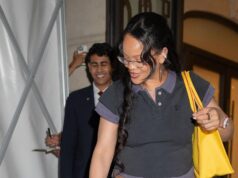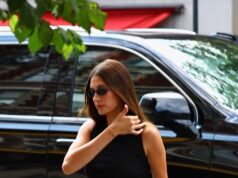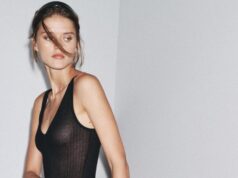“They’re part of my design process!” Ewan McGregor retorts as Halston in Netflix’s latest miniseries on the rise–and fall—of the American fashion designer. In the scene, Halston is being chastised for his careless spending, and someone has suggested he give up his orchid habit. Throughout the show, we see his atelier, workspace, and townhouse teeming with the tropical flower—a sign of the man’s staunch dedication to living in luxury.
Like his beloved orchids, Halston’s work was sumptuously minimal. His disco-goddess gowns rarely featured anything they didn’t need; a no-frills aesthetic allowed shapes (of the clothes but also the women beneath) to command attention. The adornment was little, but there was character in Halston’s swirling batik treatments or the aquatic glisten of an uncolored sequin paillette.
Through a series of licensing deals and his career-long devotion to wearability, the high-flying Halston lifestyle became something many American women could experience; the look was as discerning as it was welcoming. All one needed was a dab of Halston fragrance on her neck, an Ultrasuede shirtdress, and an in at Studio 54.
Below, we round up some pieces to take us all back to the glamorous heyday of Halston—shop vintage and modern Halston, Elsa Peretti wares, and don’t forget the orchids.
“I really tried to find a way to summarize what was a novel of a fashion show into a little poem,” says Jeriana San Juan, the costume designer tasked with distilling Halston’s Ultrasuede-upholstered life into just five episodes. As the show recounts the highs and lows of the Iowa-born, Indiana-raised designer’s life, we dive into 1961. The day is January 20, and JFK has been sworn in as president with his behatted wife, Jackie, by his side. She is, of course, wearing a pillbox hat designed by Halston back when he was a milliner at Bergdorf Goodman.
The show powers through that decade and into the next—the era Halston helped to define. Getting it right was crucial. “I really, full-on, started to consume everything I possibly could to be well-researched and to understand his world,” San Juan says. “I used the archives at Vogue and at Condé Nast and went through looking for the earliest mentions of Halston; everything from editorials to reviews of his collections to features on some of his muses.”
San Juan was also privileged enough to meet some of the gaggle of artful characters Halston surrounded himself with—those muses who helped to build the foundation for his empire. She met with Chris Royer (one of the Halstonettes, along with Pat Cleveland, Alva Chinn, Karen Bjornson, Liza Minnelli, and Elsa Peretti) who was a house model for Halston; consulted Naeem Khan, who had been his assistant once upon a time; and also Gino Balsamo, who made clothes for the Halston label and the man himself. Along the way, San Juan collected and handled Halston originals (“They look fairly simple to the eye, but they’re really not simplistic. They’re quite complex”), and understood the way Mr. Halston himself dressed. Through Balsamo, she was able to recreate a pair of sailor pants without a side seam, worn by Halston—often with a black turtleneck and his omnipresent pair of sunglasses.
In the show, which unfolds like a never-ending fashion parade, we see a lot of Halston looks—some, exact replicas of what once was; others, faithful reimaginings of originals made by San Juan, and ’70s-era vintage. “I always do a few [identical pieces] so that people who knew the subject well would be able to clock those things and feel the authenticity,” she says, “but then I also jazzed and riffed on ideas.”
For the fashion-history-making Battle of Versailles, San Juan explains how she infused her designs with a cinematic touch. “I really did try to emulate some of Halston’s silhouettes that he was showing at Versailles, but I did take a creative license on color, some fabrications, and I also added capes to a bunch of dresses,” she says. (San Juan’s sketches from the scene are pictured above.) “I knew we wanted to see fabric consume the stage. I wanted to have an opportunity for the camera to capture fabric moving closer to the face, which I think really paid off and created elegance and grace and movement.”
The easiest way to costume a ’70s-era show? Vintage, of course. San Juan scoured the internet daily for vintage Halston and Halston-era pieces to dress the entire cast, especially in the models’ off-duty looks. “I’ve never been on set as much and as often as I was on Halston because I was also dressing every mannequin in the background!” she says. She trawled the vintage troves on 1stDibs and at vintage shows, finding a pair of suede shorts that were just made for Dilone (who plays Pat Cleveland) and a very rare Elsa Peretti belt at the annual Manhattan Vintage Clothing Show.
“I had the opportunity to study his clothes firsthand, and what I digested from it all was an artistry,” she says. “He was conveying very complex ideas in a very simple way. And that’s what makes them so timeless. They are art pieces and fashion pieces that live through time, but not really with any specific timestamp on them. When you’re looking at vintage Halston, it’s very hard to date it. And that’s the beauty of it—they’re just as relevant and just as exquisite today.”
Below, a selection of vintage Halston, curated partly by San Juan:
In January of 2020, Halston announced Robert Rodriguez as its new creative director. One collection in, Rodriguez and his team were made aware of Netflix’s forthcoming miniseries directed by Daniel Minahan, and it was at once decided that a celebratory collection was in order.
“They sent me a deck of vintage styles from Halston that they were featuring in the series,” says Rodriguez. “Jeriana San Juan showed me what Elsa Peretti was wearing and what Liza Minelli was wearing. So we picked about 10 different looks that were featured, and I reinterpreted those looks for the modern-day.”
Next month, at Saks Fifth Avenue and Neiman Marcus, the Halston x Netflix collection will drop. Per Rodriguez, it features batik textiles, pleated and shimmering fabrics, and a caftan with a bodysuit underneath. One of the dresses, a floaty red chiffon gown, is pictured above.
“It was a very special project because he was always very influential to me,” Rodriguez says of Halston. “He was a tremendous inspiration throughout my career, and it was a treat—a thrill—just to carry forward his legacy through Netflix and capture the moment.” As we wait for the collection to arrive, browse a few Halston pieces that embrace the disco-essence of their predecessors, below.
In the miniseries, we see Halston move from a well-appointed apartment in the Upper East Side into an architectural marvel of a townhouse on Manhattan’s East 63rd Street. Built by the Brutalist-leaning concrete proponent Paul Rudolph, the townhouse was as novel as Halston’s Ultrasuede shirtwaist dress. The four-bedroom home was furnished with spartan restraint; Halston covered the floors with a gray velvet carpeting he developed with the company Karastan, and sprinkled in gray flannel seating that seemed to hover above the floor. Of the minimal achromatic scheme, Halston believed his guests should help to color the space—perhaps in one of his batik caftans? The pièce de résistance of the room was a floating staircase that led upstairs to the bedrooms (one of which was the site of Brigitte Bardot’s honeymoon). Elsewhere, Warhols hung on the walls and Elsa Peretti’s silver candle holders sat atop Lucite nesting tables. A thicket of bamboo filled an atrium at the back of the living room and craning their elegant necks all around was a collection of Halston’s orchids. It was a home where Halston was known to host raucous parties that could rival those at Studio 54. A certain Tom Ford is now the owner of the hallowed place.
It’s reported that Halston first saw Ultrasuede on Issey Miyake in Paris in 1971. The artificial fabric, woven from supple microfibers evoking suede, became Halson’s signature. In the fall of 1972, Halston would make waves with his “model number 704” dress cut in the novel textile, after which the garment flew off shelves. A straight-cut shirtwaist dress with set-in sleeves and a pointy, oversized collar that splayed out across the collarbone, the dress epitomized the easy elegance Halston had been so devoted to. With a subtle borrowed-from-the-menswear-department allure, the piece represented a kind of freedom—most particularly where the care of the garment was concerned. Halton’s Ultrasuede was not only water-resistant but machine-washable, too. The 704-clad woman could pack the dress onto her carry-on, trot the globe, wash, hang dry, and repeat. In December of 1972, Vogue photographed Halston amongst his Halstonettes, declaring. “A Great Year for Halston.” That, it was indeed.
During the era of Halston, glamour, from head to toe, was a prerequisite. Above sleek Ultrasuede separates and plunging sequin halter dresses, Halston-worthy makeup was all about enhancing one’s individual beauty with the right amount of color and sheen—adapted for day and night, of course. No matter what, healthy, glowing complexions were amplified with swirls of vivid blush and highlighter dusted on the cheekbones. To play up gazes, soft, delicate brows were paired with shimmering pastel shadows and swipes of mascara on the top and bottom lashes. “No liner and no fake lashes!” says makeup artist Sandy Linter. Dewy pouts were pink and peachy and finished with a high-shine lip gloss.
By night at Studio 54? The smolder, saturation, and wattage were all turned up for dance-floor dazzle. “He loved a strong, black smokey eye,” recalls Linter, who gave Halston muse Elsa Peretti just that for a spread in Vogue’s February 1975 issue lensed by Deborah Turbeville at Halston’s home. And even with smoked-out lids, “the cheeks could still be pink, the lips could still be red,” Linter says, noting the designer’s proclivity for vividly draped cheekbones and a classic crimson lip. After all, by the late ’70s, the painterly, more-is-more “evening face” of fellow Studio 54 regular and makeup pioneer Way Bandy was out in full force.
But anywhere, anytime, a spritz of Halston’s eponymous fragrance—a spicy floral bouquet with its notes of marigold, jasmine, and mossy Chypre, and housed in that unmistakable bottle designed by Peretti—was the ultimate finishing touch. As writer Carina Chocano once put it, “Halston’s influence on American fashion goes beyond his designs—he took an era, reupholstered it in Ultrasuede, dabbed ‘Halston’ on its pulse points and made it his own.” —Lauren Valenti
Halston knew the importance of a great accessory. One of his muses was Elsa Peretti, who helped craft the Halston aesthetic before she branched out and made a name for herself at Tiffany & Co. Her sterling silver jewelry boasted an off-kilter curvaceousness that winked at the female form, and she took things to the next level when she traded silver chains for stripes of cords and leather. Her pieces were utterly sensual and hung around the necks of women who dared to semi-unbuttoned their shirtwaists. Halston’s dresses were also pumped up with discotheque platforms, subtle metallics, and handbags with as much shimmer as a mirrorball.









